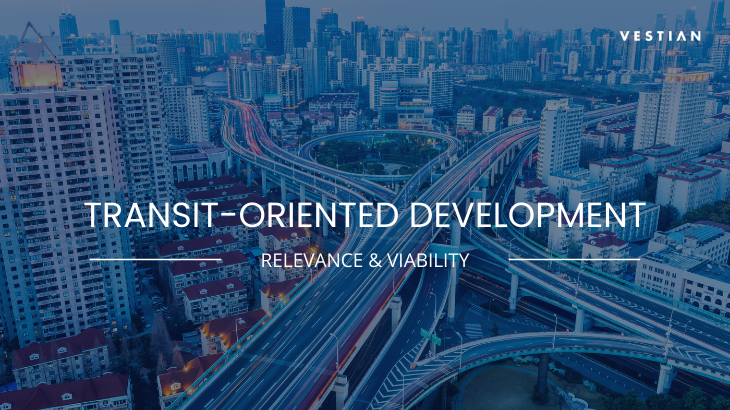India is one of the fastest growing nations of the world in terms of urbanisation. With population projected to reach 600 million by 2031, the load on metropolitan cities is set to increase manifold. The last few decades have seen a great strain on these cities’ resources, particularly on public transport and overall traffic situation, owing to a large share of the Indian youth population moving to major cities such as Bengaluru, Chennai, Mumbai and NCR for higher education, better job opportunities and plans of settling down. A major issue faced by these metro cities involves constrictive urban mobility, which, if not tackled, would prove to be an impediment to their future growth and development. This provides a unique opportunity for the adoption of Transit-Oriented Development (TOD), touted to be a pragmatic approach to mobility bottlenecks, that could support the cities’ ecosystem and citizens’ interest by reducing travel time, congestion as well as emissions.
Urban issues and TOD as a key enabler
TOD, defined as a walkable, mixed-use form of development within a walking and cycling radius of a mass transit station, encourages people to live near transit services, thereby decreasing their dependence on private vehicles. In such projects, development is effectuated by keeping pedestrians a priority. Creation of pedestrian-friendly spaces and maintaining every amenity required at a walking distance will help solve issues such as traffic congestion, air pollution, energy consumption, etc. TOD also ensures the integration of land-use and transportation by promoting higher densities and diversity along transit nodes, with support from traffic demand management tools that minimize parking, promote public transportation, and draw out pedestrian and bicycle ways.
More importantly, TOD strives to incorporate the notion of inclusiveness across all aspects, since the goal of urban design is to create a cohesive structure, integrating and complementing activities and uses. Thus, through a range of dwelling styles and options in mobility and lifestyle choices, TOD seeks to address inclusiveness in terms of various economic positions, gender and social demands, lending a sense of peace and safety.
Lessons from Singapore
In terms of urbanization and city development, Singapore is considered a model for many reasons, such as efficient land use planning for long-term use, along with quality housing development. Considered to be a land of opportunity as well as a tourist attraction, Singapore sees a large population influx and managing this rapid growth was a huge task. Thus, 1970 onwards, Singapore started developing a Mass Rapid Transit system along with a futuristic vision of town planning based on the principle of TOD. Singapore’s TOD largely involves urban regeneration and a transit network growth. A ring of satellite towns surround a central core, with train lines connecting them to industrial parks and the city centre. These satellite towns are self-sufficient, with public amenities within walking distance and a reduced need to travel for necessities.
Taking cues from Singapore, TOD in India can be utilized for initiatives that hold potential, rather than the entire network, under proper circumstances. TOD and strong urban plans that support cities’ mass transportation projects could augment developers’ and investors’ interest in creating sustainable development, which in turn, would help script the country’s economic growth.
Challenges along the way
Rising population, underdeveloped public transport system, unorganised sprawl are some of the issues that plague most of the cities. Retrofitting TOD too has been a huge challenge on account of the unavailability of land as well as the fact that regulatory framework of most municipalities are not supportive of TOD. This is specially so in the case of metro cities, where provisions such as maximum floor area ratios, height restrictions, landscaping regulations, and minimum parking requirements frequently obstruct the development of TOD and its seamless integration into city legal frameworks. The physical limitations imposed by zoning rules often prevent the development required for TOD. Till now the model for urban cities development was automobile-oriented so most of these codes had been developed accordingly. However, with the Ministry of Urban Development formulating a ‘National Transit Oriented Development Policy’, a viable solution for issues hampering TOD seems to be on the horizon.
Another major issue which TOD projects have to tackle is identifying and addressing systemic financing gaps. Comprehensive financial planning is necessary to ensure a continual flow of required resources for implementation and long-term operation. Furthermore, the city’s economic situation, political will and stakeholder capacity can all have a significant impact on TOD outcomes. These obstacles notwithstanding, quite a few cities in India are working on TOD proposals built around large rapid transit investments in metro-rail or BRTS.
Summing up
The concept of TOD has a wide horizon to spread in India given the number of challenges coming its way. Eventually, with adequate cognizance and implementation, it will help in easing gnawing issues such as climate change, traffic congestion and public transport network, amongst others, thus bringing forth sustainable development. With cities such as Delhi, Ahmedabad and Bengaluru already having introduced some provisions of TOD into their Development Plans, more cities are expected to join the bandwagon. Going forward, TOD will be one of the key elements to achieve sustainable urban transformation in collaboration with policies such as AMRUT, Smart Cities project, green mobility schemes, etc. All it requires is proper allocation of funds from the government along with the required change in laws.
